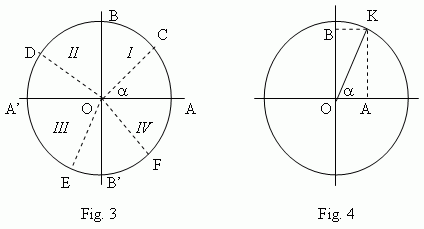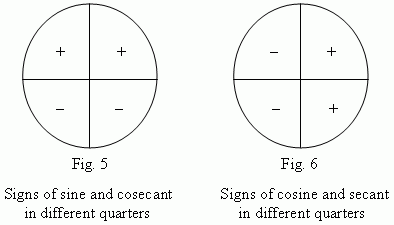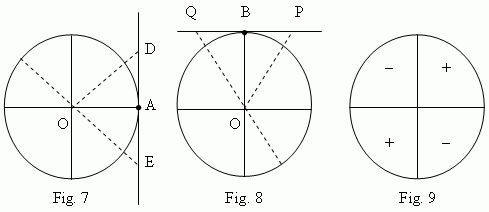Trigonometric functions of any angle
Negative and positive angles. Quarters of a unit circle.
Sine and cosine lines. Sine. Cosine. Signs of sine and
cosine in different quarters of a unit circle. Tangent
and cotangent lines. Tangent. Cotangent. Signs of
tangent and cotangent in different quarters of a unit
circle. Secant and cosecant.
To build all trigonometry, laws of which would be valid for any angles ( not only for acute angles, but also for obtuse, positive and negative angles), it is necessary to consider so called a unit circle , that is a circle with a radius, equal to 1 ( Fig.3 ).

Let draw two diameters: a horizontal AA’ and a vertical BB’. We count angles off a point A (starting point). Negative angles are counted in a clockwise,
positive in an opposite direction. A movable radius OC forms angle
![]() with
an immovable radius OA. It can be placed in the 1-st quarter ( COA ), in the 2-nd quarter ( DOA ), in the 3-rd quarter ( EOA ) or in the
4-th quarter ( FOA ). Considering OA and OB as positive directions and OA’ and OB’ as negative ones,
we determine trigonometric functions of angles as follows.
with
an immovable radius OA. It can be placed in the 1-st quarter ( COA ), in the 2-nd quarter ( DOA ), in the 3-rd quarter ( EOA ) or in the
4-th quarter ( FOA ). Considering OA and OB as positive directions and OA’ and OB’ as negative ones,
we determine trigonometric functions of angles as follows.
A
sine line
of an angle
![]() ( Fig.4 ) is a
vertical
diameter of a unit circle, a
cosine
line
of an angle
( Fig.4 ) is a
vertical
diameter of a unit circle, a
cosine
line
of an angle
![]() - a
horizontal
diameter of a unit circle. A
sine
of an angle
- a
horizontal
diameter of a unit circle. A
sine
of an angle
![]() ( Fig.4 ) is the segment OB of a sine line, that is a projection of a movable radius
OK to a sine line; a
cosine
of an angle
( Fig.4 ) is the segment OB of a sine line, that is a projection of a movable radius
OK to a sine line; a
cosine
of an angle
![]() - the segment OA of a cosine line, that
is a projection of a movable radius OK to a cosine line.
- the segment OA of a cosine line, that
is a projection of a movable radius OK to a cosine line.
Signs of sine and cosine in different quarters of a unit circle are shown on Fig.5 and Fig.6.

A
tangent line
( Fig.7 ) is a tangent, drawn to a unit circle through the point A of a
horizontal
diameter.
A
cotangent line
( Fig.8 ) is a tangent, drawn to a unit circle through the point B of a
vertical
diameter.
A
tangent
is a segment of a tangent line between the tangency point A and an intersection point ( D, E, etc., Fig.7 ) of a tangent line and a radius line.
A
cotangent
is a segment of a cotangent line between the tangency point B and an intersection point ( P, Q, etc., Fig.8 ) of a cotangent line and a radius line.
Signs of tangent and cotangent in different quarters of a unit circle see on Fig.9.

Secant and cosecant are determined as reciprocal values of cosine and sine correspondingly.